Headwear
For the purposes of this page, only headwear distributed to line infantry will be addressed here.
Note: All images used without permission. Original sources are cited at bottom of page.
Regulation kepi in August 1914
M1884: This was the kepi that soldiers marched off to war with in August 1914. In appearance, it differed little from mid-19th century models. Made of wool, the M1884 was composed of six pieces: the band in dark blue, the turban (consisting of four pieces) in garance “(madder”) red and the cap, also in madder red. The height was 90 mm in the front and 150 mm at the back. The band was 40 mm high. The visor was black leather and measured 45 mm at its center. The M1884 was made in three different sizes: 140, 145 or 150 mm in diameter. There were two metal aeration vents, 15 mm in diameter and pierced with seven holes, in the color of the cloth (madder red for infantry). The chinstrap was black leather, secured by two small uniform buttons (imprinted with an exploding grenade). All seams were hidden by a dark blue wool piping.
A headband of blackened animal hide, 50 mm high, was sewn to the interior of the kepi, along with a cover piece sewn against the backside of the cap. In comparison to the all-encompassing pieces used in other services (e.g. the artillery, engineers, cuirassiers and dragoons), the infantry version was referred to as reduced. A circular patch was cut in the center of the cover piece could be flipped back and a piece of cloth inserted between it and the wool on which the soldier would inscribe his last name and company (alternately, a regimental, manufacturer, serial number or size stamps appear here). Between the headband and the wool was a shell of treated linen liner maintained by the turned-down vent teeth and a few stitched points. Though in theory the shell was to always be included in war-time, depleted stocks in 1914 meant that some reserve regiments were provided kepis without the shell, which lent the hat a truly formless shape.
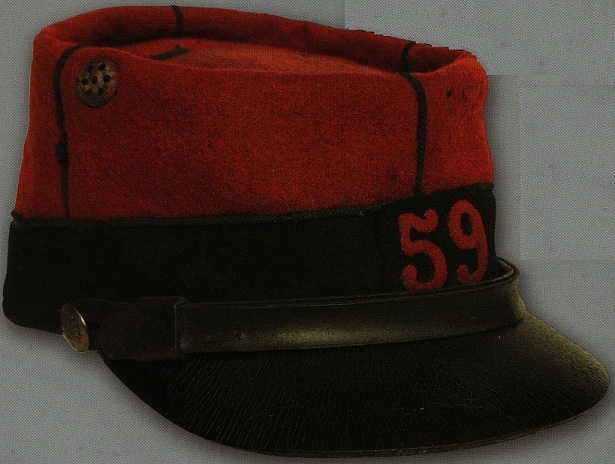
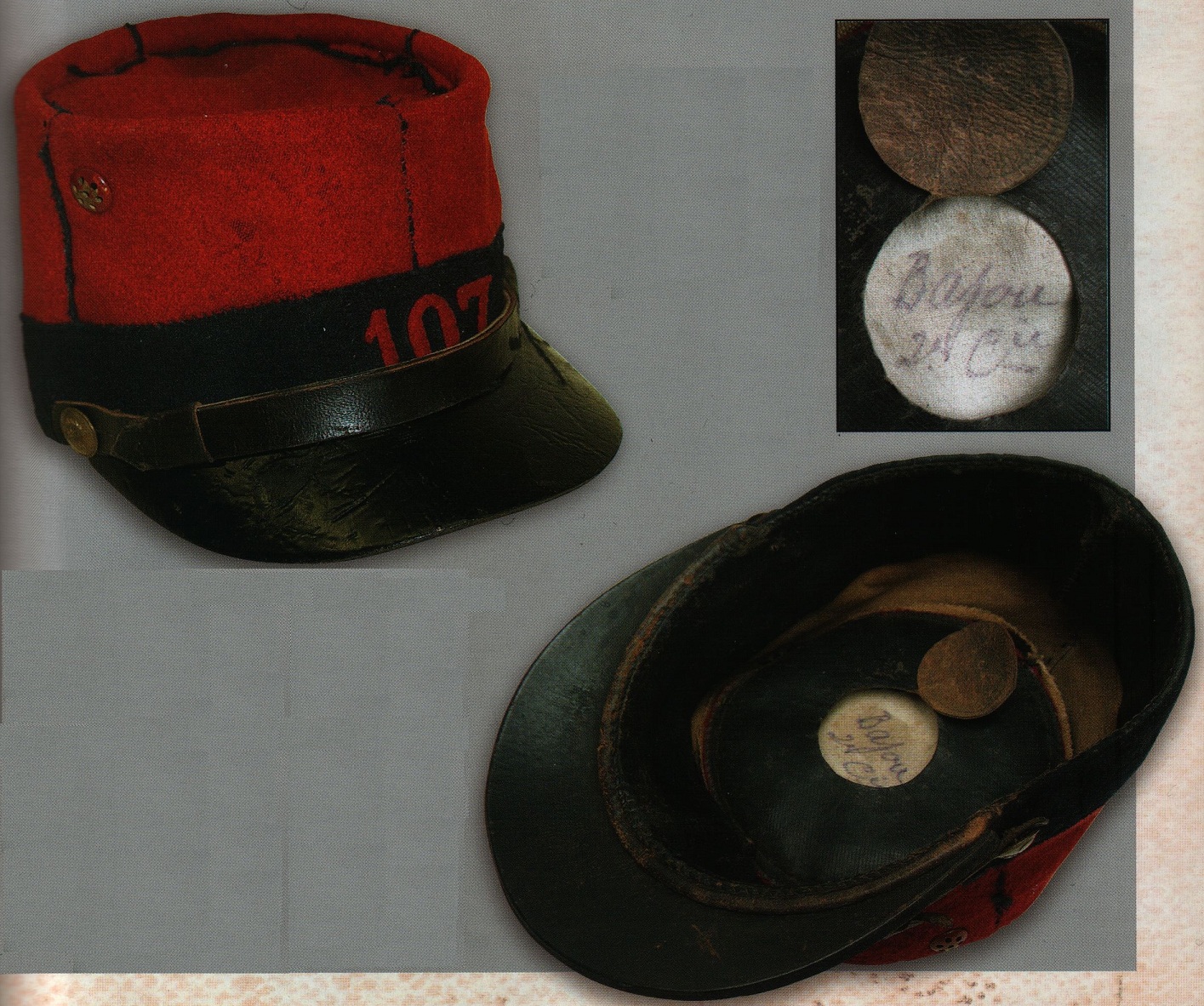
Two examples of the M1884 kepi.
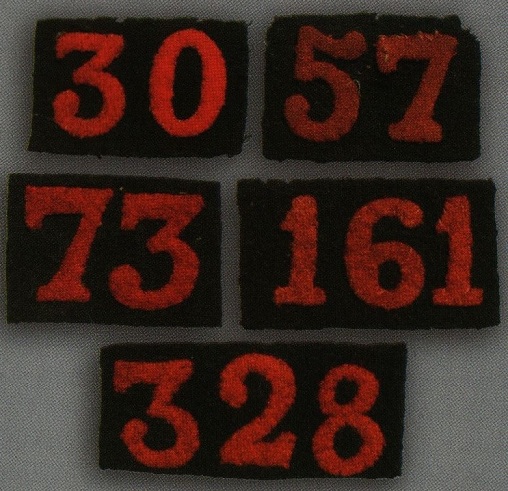
The regimental insignia consisted of digits cut from fine madder red wool (NCOs wool), 25 mm high, which were sewn onto a dark blue patch 40 mm high and 3, 5 or 7 cm wide, depending on the number of digits needed (1-3). Out of urgency, some reservists wore kepis that were garnished with the old style insignia that had originally been sewn to the greatcoat. Thus, examples exist of insignia patches bordered with madder red piping, insignia cover-patches or insignia where the color of the digits and the patch were reversed.
Regulation kepi in September 1914
After a month of war where the conspicuous appearance of the French uniform factored into the catastrophic losses suffered by the army, it was quickly realized that immediate measures had to be taken to reduce the visibility of the soldier. Yet at the same time, decision-makers didn't want to deprive the French soldier of his traditional distinctive silhouette. Thus, while the kepi would be retained, alternative colors and simpler designs were adopted. This all made for a diverse variety of kepis in use at the same time. What follows are the most common variants:
Simplified M1914 1st Type:
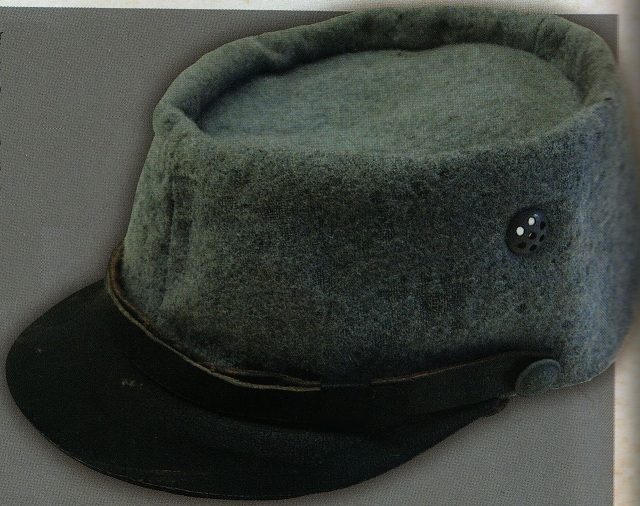 As the title states, the simplified M1914 was created, per the decree of 14 September 1914, to ease and expedite production of the kepi. While the intention was to have the kepi fabricated entirely in the new "light blue" cloth (referred to at this time as "bluish gray"), the Quarter-Master had to rely on all available materials. Thus, the simplified kepis would be made in both the new light blue (itself varying in shade from ash blue to medium blue to dark blue-gray) and the old iron blue or dark blue wool. The second specification was that the band and turban were made into a single band in two parts, which are joined on either end, the seams being found on the front and back of the kepi. Finally, the piping was eliminated from the kepi. Chinstraps were made in both black and, non-regulation brown leather. The interior shell continues to be made of treated linen but potato sacking was also employed. The small uniform buttons (in bronze but mostly in tin or zinc) continued to be used, either painted in the color of the cloth or left unpainted. Plain metal buttons were also used.
As the title states, the simplified M1914 was created, per the decree of 14 September 1914, to ease and expedite production of the kepi. While the intention was to have the kepi fabricated entirely in the new "light blue" cloth (referred to at this time as "bluish gray"), the Quarter-Master had to rely on all available materials. Thus, the simplified kepis would be made in both the new light blue (itself varying in shade from ash blue to medium blue to dark blue-gray) and the old iron blue or dark blue wool. The second specification was that the band and turban were made into a single band in two parts, which are joined on either end, the seams being found on the front and back of the kepi. Finally, the piping was eliminated from the kepi. Chinstraps were made in both black and, non-regulation brown leather. The interior shell continues to be made of treated linen but potato sacking was also employed. The small uniform buttons (in bronze but mostly in tin or zinc) continued to be used, either painted in the color of the cloth or left unpainted. Plain metal buttons were also used.
The same official notice of September 1914 also specified that the regimental insignia for line infantry was to now have digits cut from blue gray wool on a madder red patch. In reality, the old insignia (madder red digits on dark blue patch) were widely employed by the depots, where the insignia was applied. Various alternative designs also appeared, including examples where the digits were sewn directly onto the front of the kepi.
Simplified M1914 2nd Type:
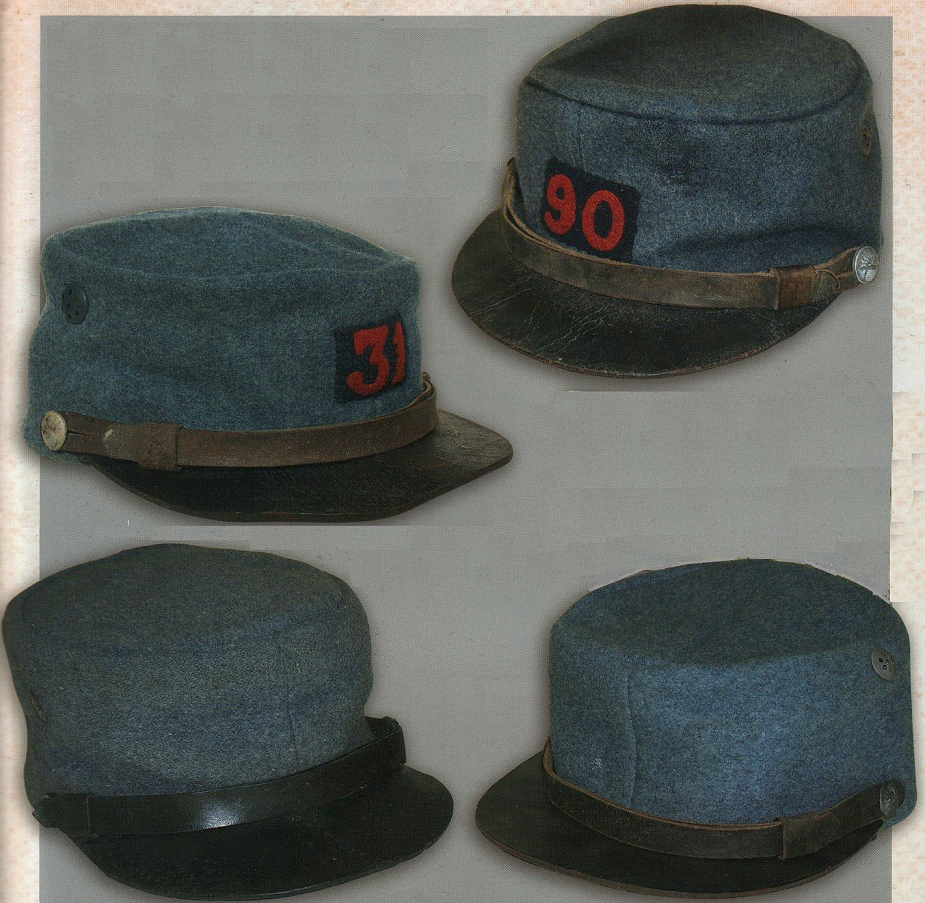 The M1914 2nd Type was intended to be the definitive pattern kepi to be employed for the duration of the war. It came out of the notice of 9 December 1914. The two primary specifications were that the visor and chinstrap only be made of black leather and that the seam edges of the top of the kepi be brought up to level (contrary to previous models where the seam edges were one centimeter below the actual top). The first specification addressed the use of brown leather chinstraps on the 1st Type kepi, though examples exist of 2nd Type kepis were brown chinstraps. The second specification was intended to prevent the pooling of water on the top of the hat. As such, the height of the back of the kepi was reduced to 115 mm while the front was lowered slightly to 80 mm. The diameter of the cap was 145 mm. From 1915 on, regimental insignia consisted of digits cut from dark blue cloth on a horizon-blue patch.
The M1914 2nd Type was intended to be the definitive pattern kepi to be employed for the duration of the war. It came out of the notice of 9 December 1914. The two primary specifications were that the visor and chinstrap only be made of black leather and that the seam edges of the top of the kepi be brought up to level (contrary to previous models where the seam edges were one centimeter below the actual top). The first specification addressed the use of brown leather chinstraps on the 1st Type kepi, though examples exist of 2nd Type kepis were brown chinstraps. The second specification was intended to prevent the pooling of water on the top of the hat. As such, the height of the back of the kepi was reduced to 115 mm while the front was lowered slightly to 80 mm. The diameter of the cap was 145 mm. From 1915 on, regimental insignia consisted of digits cut from dark blue cloth on a horizon-blue patch.
The notice also decreed that the cloth to be used was the new "light blue" wool. Other specifications included the elimination of the cap reinforcement, that the vents and buttons were to be painted in the same color as the cloth, and that there was to be no piping or regimental insignia. This last specification would often go ignored as photographs from the time show the presence of regimental insignia well after December 1914.
Non-regulation kepis
There are two categories of kepis that fall under the title of non-regulation models. The first is kepis delivered to the army by manufacturers in the framework of the official design but which did not adhere to the exact specifications made. The second category is private purchase kepis.
.jpg?dl=0)
M1884/14 1st Type: With the first shipments of the new uniform cloth, manufacturers begin to produce kepis in the cloth without waiting for the description given in the official notice of 19 September 1914. As such, kepis identical in cut and ornamentation to the existing M1884 were produced with the exception that all pieces were made entirely of the same color cloth. The old iron blue wool was used, as was dark blue and the new light blue (again, in various shades). They were also still garnished with dark blue piping. Light blue piping was also used.
 Even after the official decree was presented though, manufacturers continued to make what is referred to as the M1884/14 1st Type. The reason for this is that it allowed manufacturers to both adhere to army regulations and use all available cloth while still making a profit. Thus, the band and turban would be cut from five small pieces and not two as done previously. Additionally, the old patterns and stamping-pieces could still be used and not discarded. In the army's desperate need for kepis, these hybrid kepis were accepted and distributed to the ranks.
Even after the official decree was presented though, manufacturers continued to make what is referred to as the M1884/14 1st Type. The reason for this is that it allowed manufacturers to both adhere to army regulations and use all available cloth while still making a profit. Thus, the band and turban would be cut from five small pieces and not two as done previously. Additionally, the old patterns and stamping-pieces could still be used and not discarded. In the army's desperate need for kepis, these hybrid kepis were accepted and distributed to the ranks.

M1884/14 2nd Type:
All colors of cloth continued to be employed in what is referred to as the M1884/14 2nd Type, despite the publishing of the official decree of September. The only difference between the 1st Type and the 2nd Type is that the latter saw the elimination of the piping. The same rules as to why the non-regulation kepis continued to be produced by manufacturers and accepted by the army apply here. Production of the M1884/14 2nd Type would continue until the notice of December 1914 where particulars of the M1914 kepi were outlined.
Felt Kepi:
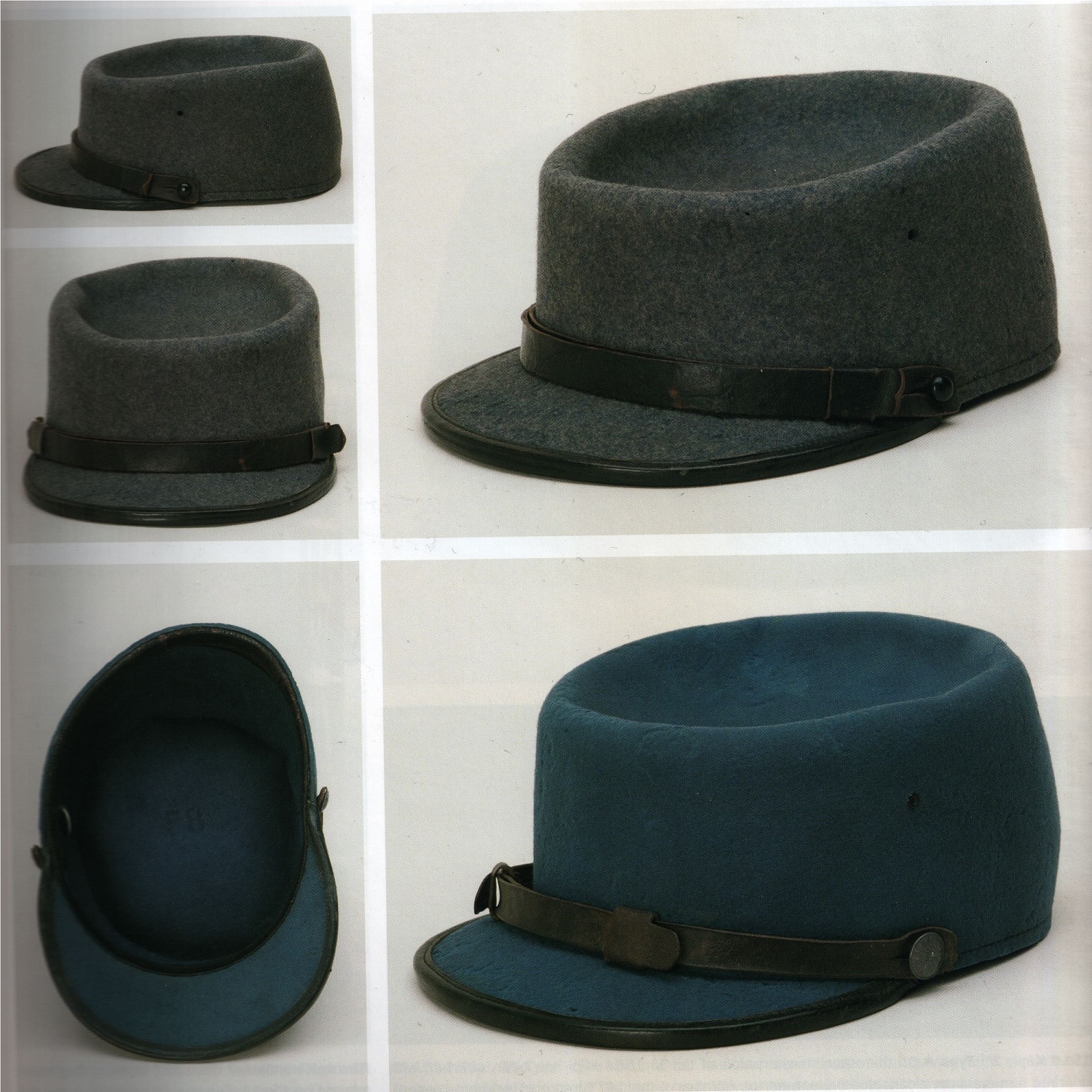 Certainly the most bizarre kepi produced was that distributed at the end of 1914. Made in two molded pieces, shell and visor bordered in leather, in a thick gray blue felt. It was fitted with the classic chinstrap. Aeration was achieved by a single eyelet on either side of the cap. It has been put forward that the felt kepi was actually a pre-war design that had not gone into production but which the Quarter-Master decided to distribute out of concerns of economy. The fragility of the felt kepis was clearly evident, as it was easily crushed when not being worn. It was also sensitive to moisture and became easily deformed in the rain. As such, the felt kepis were mostly relegated to troops at the depots and not commonly distributed to soldiers in the forward zones.
Certainly the most bizarre kepi produced was that distributed at the end of 1914. Made in two molded pieces, shell and visor bordered in leather, in a thick gray blue felt. It was fitted with the classic chinstrap. Aeration was achieved by a single eyelet on either side of the cap. It has been put forward that the felt kepi was actually a pre-war design that had not gone into production but which the Quarter-Master decided to distribute out of concerns of economy. The fragility of the felt kepis was clearly evident, as it was easily crushed when not being worn. It was also sensitive to moisture and became easily deformed in the rain. As such, the felt kepis were mostly relegated to troops at the depots and not commonly distributed to soldiers in the forward zones.
Private Purchase:
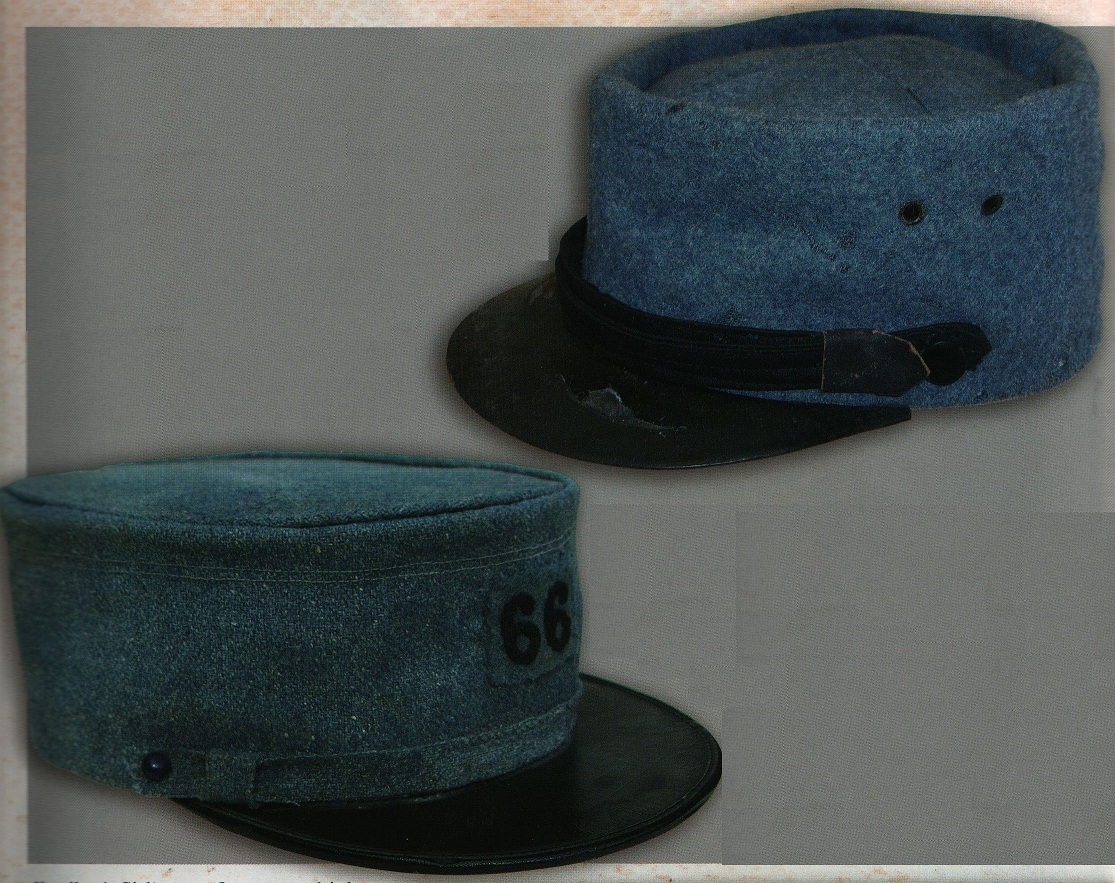 Shortly after the outbreak of war, hat makers began peddling private purchase kepis to the men. Kepis were already in private production before the war, so businesses simply stepped up the production levels. Acquired directly by soldiers with a more discerning taste or sent by loved ones back home, these kepis fall into two broad categories. With the adoption of the new infantry kepi, some manufacturers begin producing an improved version very similar to the regulation model. Made in the light blue cloth of the troop, these kepis closely resemble the M1914 1st Type with certain details that are different. The cap was made in four quarters, a nicer liner, air vents that are more discreet, and a fancier chinstrap. While tolerated by the Quarter-Master, the use of private purchase kepis amongst enlistedmen remained rare.
Shortly after the outbreak of war, hat makers began peddling private purchase kepis to the men. Kepis were already in private production before the war, so businesses simply stepped up the production levels. Acquired directly by soldiers with a more discerning taste or sent by loved ones back home, these kepis fall into two broad categories. With the adoption of the new infantry kepi, some manufacturers begin producing an improved version very similar to the regulation model. Made in the light blue cloth of the troop, these kepis closely resemble the M1914 1st Type with certain details that are different. The cap was made in four quarters, a nicer liner, air vents that are more discreet, and a fancier chinstrap. While tolerated by the Quarter-Master, the use of private purchase kepis amongst enlistedmen remained rare.
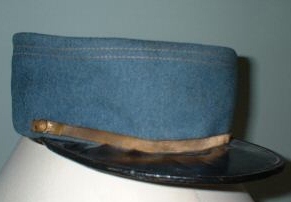 A second category of private purchase kepi, for those soldiers who had the means, was a "troop version" of the officers kepi intended for rear-area ("stepping out") use. This type was often referred to as a fantasie ("fantasy") kepi and there were two primary designs. One was the "polo" form, which had a more defined cylindrical shape (owing to a reinforced cap) and piping. The other type was the "manchon" ("muff") form, which had a low profile and a flat top, along with a false chinstrap made of cloth. Due to their cost and maintenance, both types became the privilege of soldiers in the rear-areas and were not commonly worn by front line soldiers. Otherwise, only officers and NCOs could afford to purchase one.
A second category of private purchase kepi, for those soldiers who had the means, was a "troop version" of the officers kepi intended for rear-area ("stepping out") use. This type was often referred to as a fantasie ("fantasy") kepi and there were two primary designs. One was the "polo" form, which had a more defined cylindrical shape (owing to a reinforced cap) and piping. The other type was the "manchon" ("muff") form, which had a low profile and a flat top, along with a false chinstrap made of cloth. Due to their cost and maintenance, both types became the privilege of soldiers in the rear-areas and were not commonly worn by front line soldiers. Otherwise, only officers and NCOs could afford to purchase one.
The Adrian helmet, which began mass distribution in the summer of 1915, replaced the kepi as the official on-duty headwear. This was made official by the decree of 15 September 1915, by which time most front-line formations had received the helmets. Meanwhile, on 31 July 1915 the beret had officially been decreed as the regulation off-duty headwear until the decision was supplanted on 15 September, when the police bonnet took its place. Production was ramped up on police bonnets in October-November 1915 but until such time as they received police bonnets, soldiers continued to wear berets and kepis when off-duty. By winter of 15-16 most soldiers had received the bonnet, and while the kepi might still have been retained in a haversack by nostalgic veterans, in 1916 it disappeared at the front.
le Couvre-Képi (kepi-cover)
M1902, M1913: Representing the only camouflaging expedient prior to the start of the war (1912), all infantrymen were supplied with a kepi-cover. The cover had a synching cord and one buttonhole on either side where the kepi buttons would secure it to the hat. The M1902 was made of white, impermeable calico dyed iron blue-gray. It had three rear button loops, intended to receive the three hooks of the neck-cover. The M1912 was produced in iron blue-gray (cretonne) cotton and on these the button loops were replaced with three rear buttons (black varnished metal). Both models were worn in 1914, however the neck-cover was typically not worn.
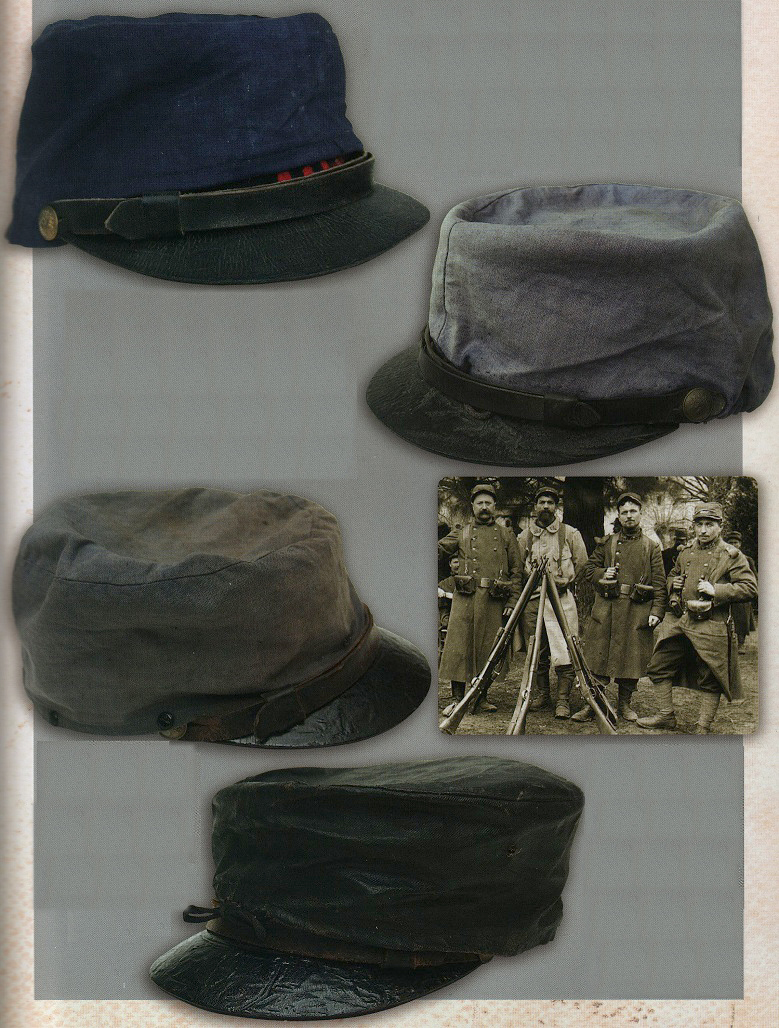 Simplified M1914: As a exigent measure, the simplified model goes into production at the beginning in August 1914 and was not equipped with the rear buttons to attach neck-cover. In principal, this model was intended for distribution among the reserve and territorial units.
Simplified M1914: As a exigent measure, the simplified model goes into production at the beginning in August 1914 and was not equipped with the rear buttons to attach neck-cover. In principal, this model was intended for distribution among the reserve and territorial units.
Alterations to the kepi-covers took two forms, one man-made and the other natural. To the first point, some soldiers opted to cut a hole in the kepi cover so that the regimental insignia was visible. The natural alteration was a feature shared by every model of kepi-cover: the rapidity at which they became discolored after continual exposure to the elements. Under the August sun, they first faded to an ash blue. Through the months, the look of the covers will be for the less disparate, turning every possible shade of blue: whitened by dust, stained by mud, greened by moisture.
Oilskin Cover: Although against regulations, many soldiers purchased kepi-covers of oilskin canvas on their own initiative. These were similarly equipped with a synching cord and, unlike the regulation model, afforded a good protection against the rain.
Kepi covers. From top to bottom: M1913; a faded M1914; faded private purchase; oilskin canvas.
le Béret (beret)
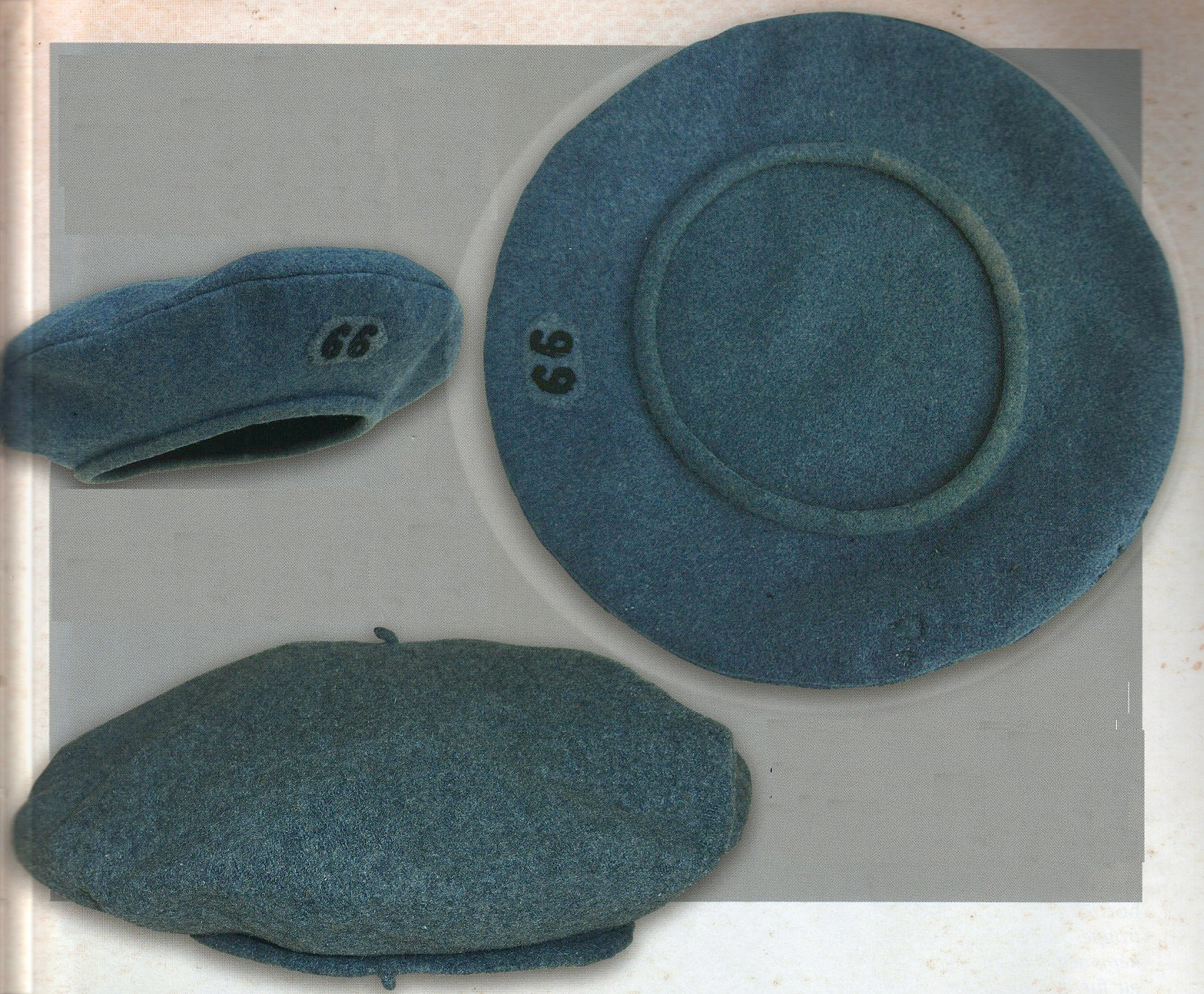
M1915:
With the adoption of the Adrian helmet in 1915, the issue arose of providing to the soldiers an off-duty hat that could be easily transported in the soldier's pack or haversack. It did not seem suitable to retain the kepi for this reason. Additionally, this option would necessitate continuing fabrication as new distributions were required. For these reasons, a simpler hat was adopted 31 July 1915 in the same design asthe elite Alpine chasseur beret but made of salvaged horizon-blue wool. It was composed of four pieces: the crown, the turban (in two parts) and the headband padding. Unlike the chasseur version, there is no interior liner. In the face of overwhelming criticism, mostly from covetous chasseurs unhappy that the garment symbolic of their elite status was distributed to the common
infantryman, the decision was reversed only a month and half later.
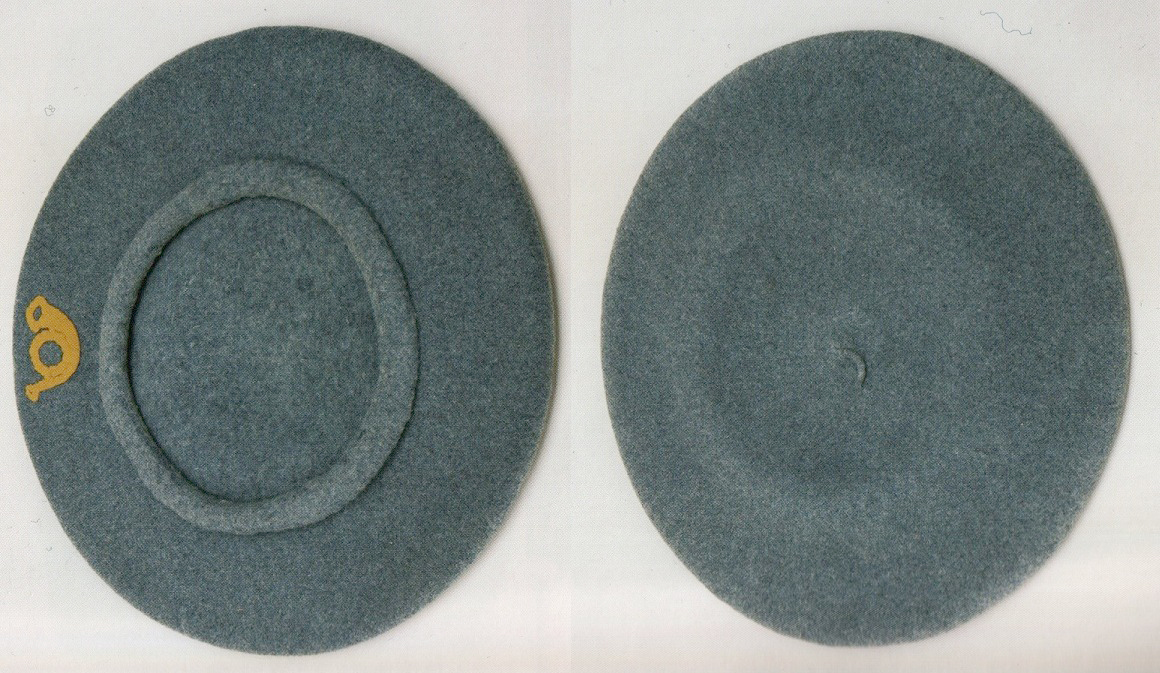 The police bonnet would serve the purpose instead. Photographic evidence suggests that the berets fell out of use largely by the fall of 1915. Moreover, French uniform regulations were generally strictly enforced, meaning that officers and NCOs would ensure that the berets were not worn. During its brief existence, 250,000 horizon blue berets would be produced and distributed. It can be said then that the beret was the ephemeral look of the French soldier in the second semester of 1915.
The police bonnet would serve the purpose instead. Photographic evidence suggests that the berets fell out of use largely by the fall of 1915. Moreover, French uniform regulations were generally strictly enforced, meaning that officers and NCOs would ensure that the berets were not worn. During its brief existence, 250,000 horizon blue berets would be produced and distributed. It can be said then that the beret was the ephemeral look of the French soldier in the second semester of 1915.
Top: regulation beret on top, private purchase on bottom.
Bottom: private purchase beret with chasseur badge.
Private Purchase: Private purchase berets were also produced. These were more traditional in appearance made of brushed horizon-blue wool and were made from a single piece of fabric, unlike the regulation model. A private purchase beret appeared in catalogs of the time selling for 5.50 Francs.
The proper way to wear the beret was to place it on the top of the head and then pull either the right or left side down so that it sloped off sharply. However, by the hat's nature, there were a multitude of ways it could be stylized depending on the preference of the wearer. Some chose to wear it pulled back. Others opted to shape the beret so that it resembled the popular civilian caps so ubiquitous at the time. Less particular soldiers kept it simple by just plopping the beret down non-stylishly on the head.
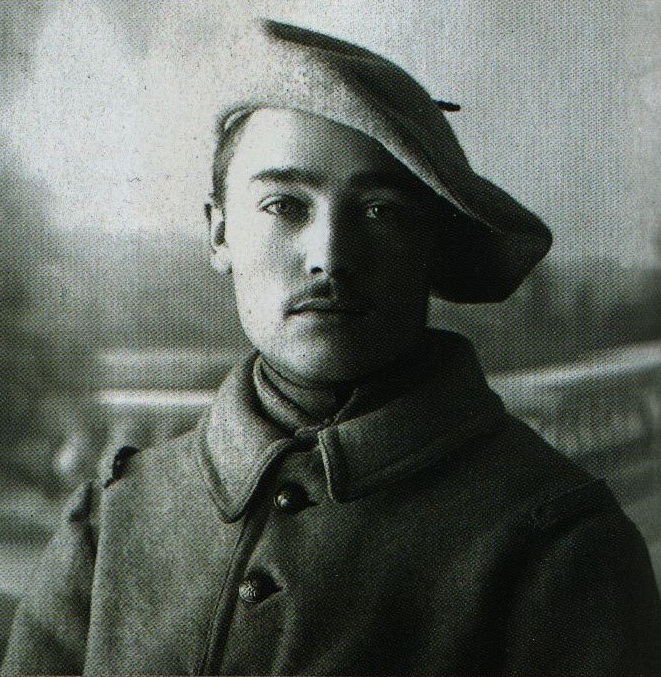

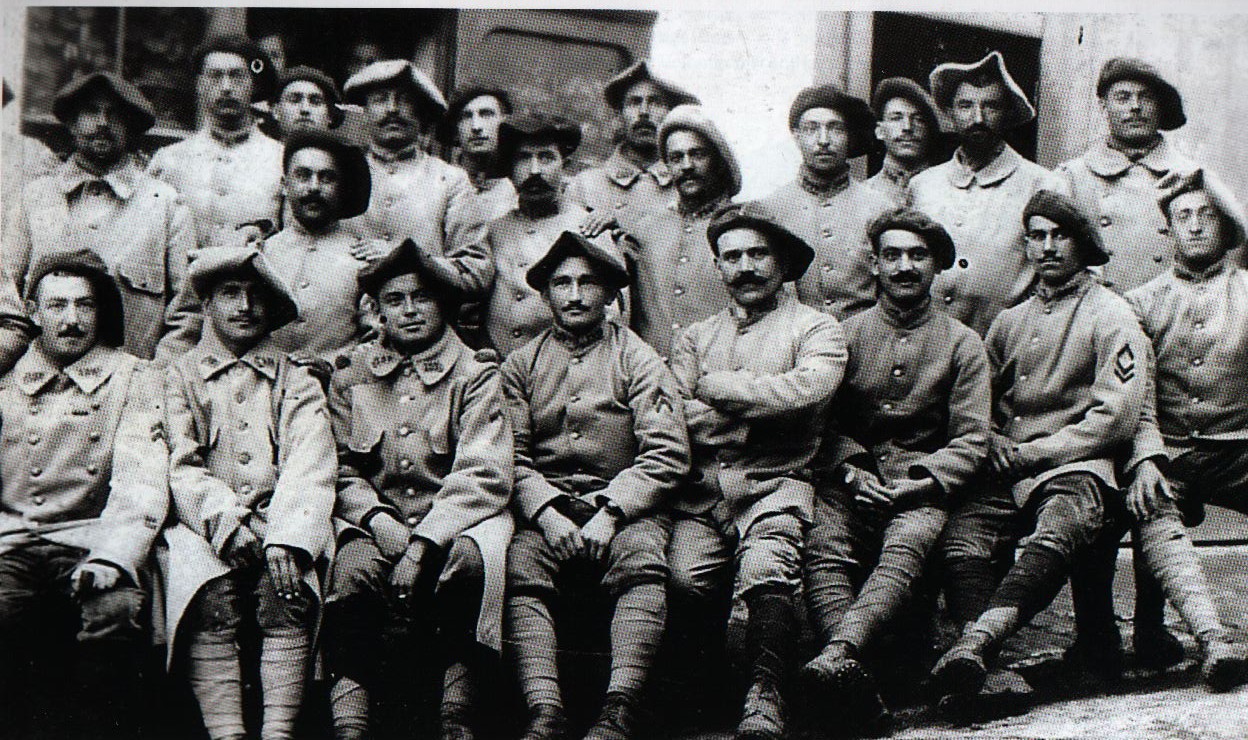
Three images showing regulation berets worn in various manners.
le Bonnet de Police (police bonnet)
M1891:
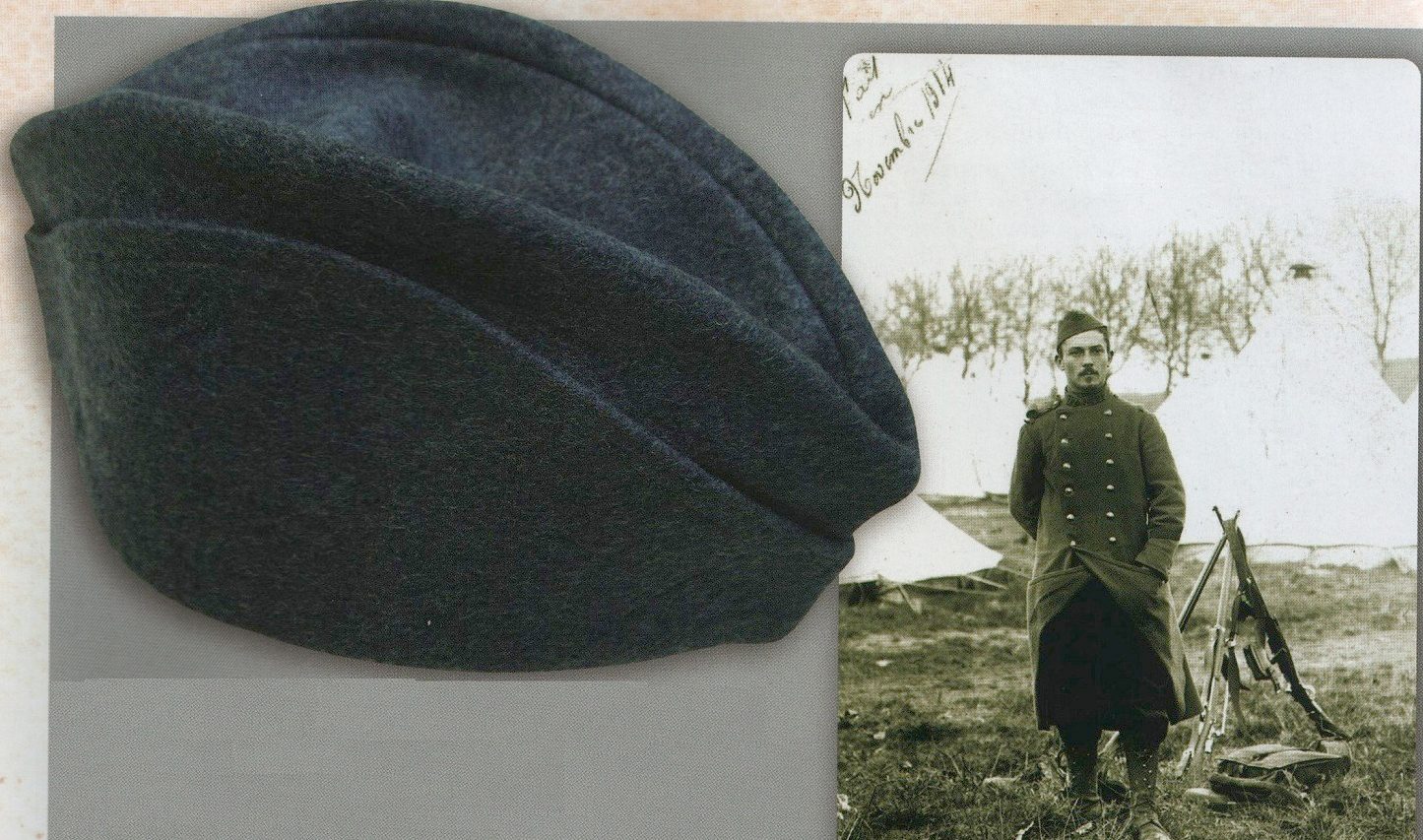 Before the war the police bonnet (more casually referred to as the calot, or "cap") was reserved for off-duty wear. As the name indicates ('police' referring specifically to the brig), it was typically worn while performing chores, punishment duties or while off-duty in the barracks. Adopted in 1891, the bonnet was made in iron blue-gray and composed of five pieces: the two flaps, the two sides of the turban, and the cap. The cap itself was folded down the center. The top edge of each flap is hemmed and mended by two parallel seams. The flaps were held up by a small metal hook sewn into the interior of the cap, which attached to a fixed loop on the turban.
Before the war the police bonnet (more casually referred to as the calot, or "cap") was reserved for off-duty wear. As the name indicates ('police' referring specifically to the brig), it was typically worn while performing chores, punishment duties or while off-duty in the barracks. Adopted in 1891, the bonnet was made in iron blue-gray and composed of five pieces: the two flaps, the two sides of the turban, and the cap. The cap itself was folded down the center. The top edge of each flap is hemmed and mended by two parallel seams. The flaps were held up by a small metal hook sewn into the interior of the cap, which attached to a fixed loop on the turban. .jpg?dl=0) The liner was made of a simple unbleached canvas headband 45 mm wide.
The liner was made of a simple unbleached canvas headband 45 mm wide.
A 1913 directive noted that the police bonnet should be carried in the field package. Thus, at the outbreak of war was present in the backpack of some units. The bonnets first began to be donned by soldiers in the autumn of 1914 with the stabilization of the front. At this time, depots distributed bonnets to those units that did not start off with the bonnets and those men going to the front as reinforcements. Despite this, many soldiers did not receive the cap as the first winter of the war began. For those fortunate enough to have one, the side flaps could be pulled down over the ears to fight the cold.
 The bonnet itself was worn either level on the man's head, or cocked off stylishly to the side. Some men wore their cap so cocked off to the side as to seemingly defy the laws of physics. On their downtime, some took a much more relaxed approach by wearing the cap on the back of the head, while others found it more comfortable to wear sideways.
The bonnet itself was worn either level on the man's head, or cocked off stylishly to the side. Some men wore their cap so cocked off to the side as to seemingly defy the laws of physics. On their downtime, some took a much more relaxed approach by wearing the cap on the back of the head, while others found it more comfortable to wear sideways.
M1891/15:
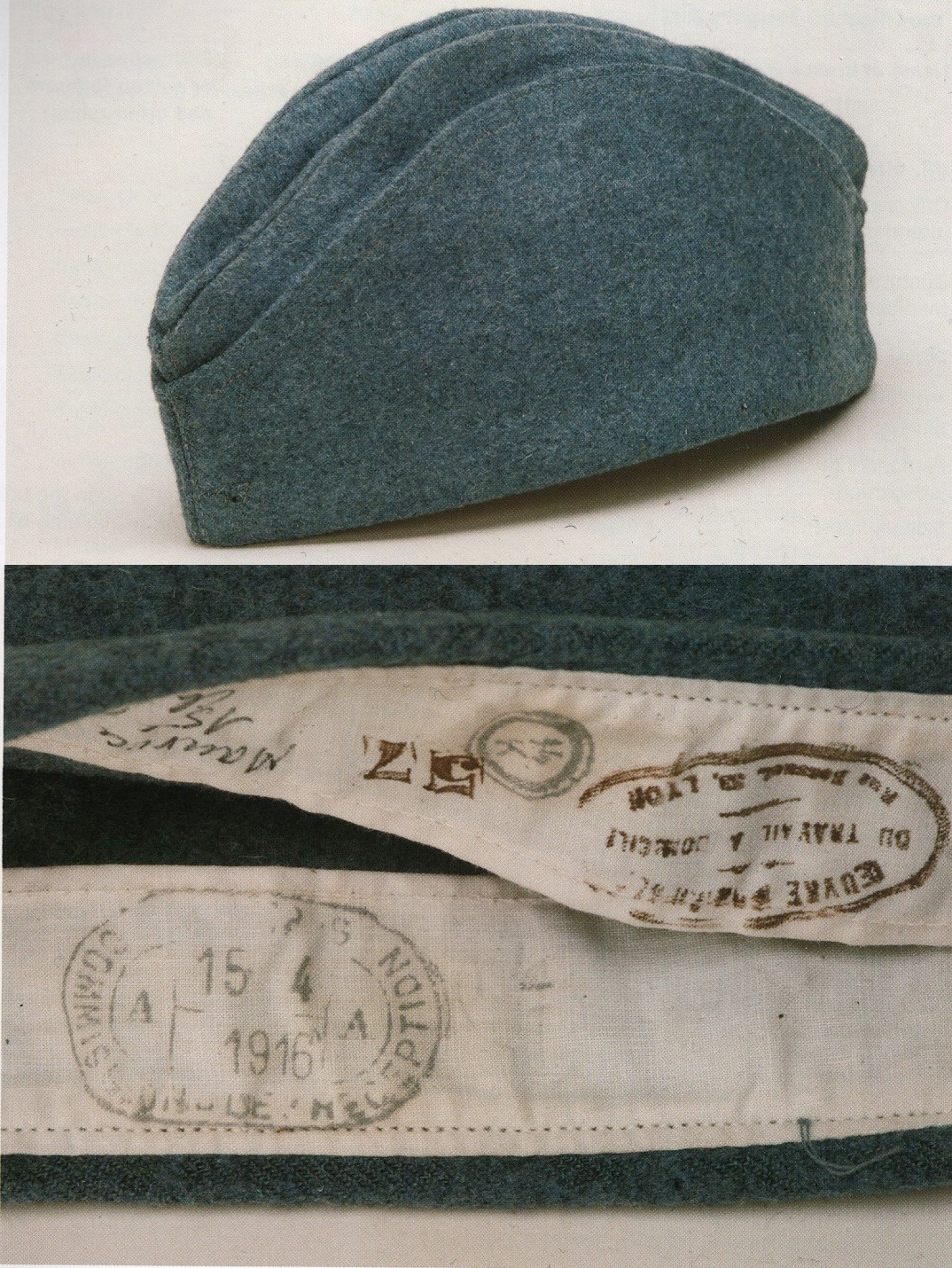 On 14 September 1915, with the decision to do away with the short-lived horizon-blue beret, the police bonnet became the official off-duty headwear. In order to ramp up productions, the M1891/15 was manufactured in the light blue wool in addition to the regulation horizon-blue, with two million being distributed in October and November 1915. The design of the modified version was nearly identical to the M1891 with the exception that the hooks meant to secure the side flaps were done away with as they were largely superfluous. Also, the interior unbleached canvas headband was replaced with a bleached canvas. The soldiers themselves preferred the kepi over the bonnet, the former providing a more distinct and traditionally military style. Even when on furlough some men preferred wearing the helmet over the bonnet. The popularity of the bonnet would improve with the introduction of later models (see below). Nonetheless, the M1891/15 was worn until the end of the war.
On 14 September 1915, with the decision to do away with the short-lived horizon-blue beret, the police bonnet became the official off-duty headwear. In order to ramp up productions, the M1891/15 was manufactured in the light blue wool in addition to the regulation horizon-blue, with two million being distributed in October and November 1915. The design of the modified version was nearly identical to the M1891 with the exception that the hooks meant to secure the side flaps were done away with as they were largely superfluous. Also, the interior unbleached canvas headband was replaced with a bleached canvas. The soldiers themselves preferred the kepi over the bonnet, the former providing a more distinct and traditionally military style. Even when on furlough some men preferred wearing the helmet over the bonnet. The popularity of the bonnet would improve with the introduction of later models (see below). Nonetheless, the M1891/15 was worn until the end of the war.
While not regulation, some soldiers chose to decorate their bonnet with unit insignia. The digits were cut from dark blue wool and either sewn onto a light blue / horizon-blue patch or simply directly onto the bonnet. Rank insignia were sometimes incorporated as well by
.jpg?dl=0) sewing thin braid (dark blue for 1st class privates and corporals, gold or silver braid for NCOs and officers) in a reverse 'V' on the front of the bonnet. Less commonly, men with special duties might incorporate some decorative flourish too, such as a musician adding the musician's braiding to the front. Again, all of these ornamentations were non-regulation but as the cap was for off-duty wear, officers seem to have turned an eye to it.
sewing thin braid (dark blue for 1st class privates and corporals, gold or silver braid for NCOs and officers) in a reverse 'V' on the front of the bonnet. Less commonly, men with special duties might incorporate some decorative flourish too, such as a musician adding the musician's braiding to the front. Again, all of these ornamentations were non-regulation but as the cap was for off-duty wear, officers seem to have turned an eye to it.
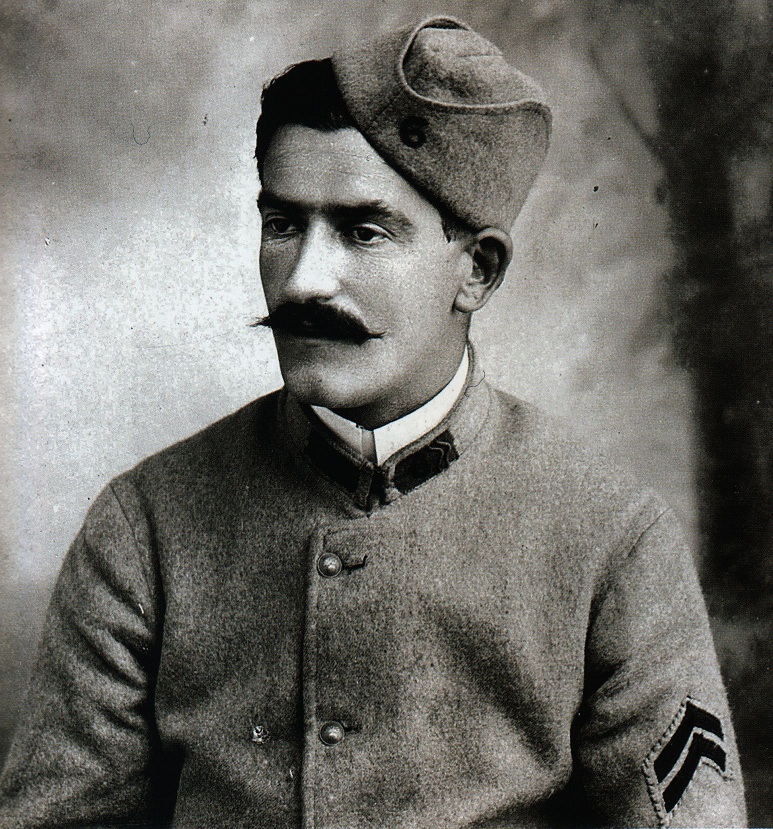
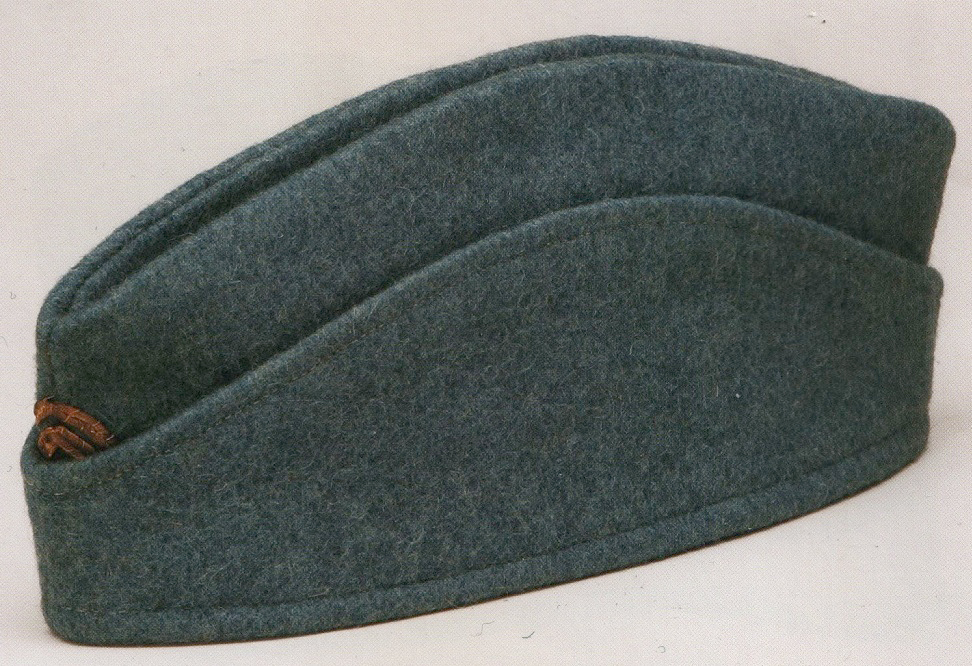
On left, M1891/15 with regimental insignia (6e RI). On right, M1891/15 with lieut. rank braiding.

M1918: In 1917, a non-regulation style of police bonnet began to be produced commercially that resembled more the style worn during the Second Empire often associated with the cavalry. Referred to as the "Empire" style, it provided a striking, martial silhouette that appealed more to many French soldiers in comparison to the subdued M1891/15. To appease the men and to create a standardized off-duty hat, the Quarter-Master officially adopted the Empire style bonnet as regulation wear on 9 August 1918.
The M1918 was easier to manufacture as it was composed
.jpg?dl=0) of only three pieces of fabric. The center fold was done away with permitting the body to be made from one single piece folded in half and sewn together along either edge. The side flaps are simplified, the edges no longer being hemmed and mended by the two parallel seams. For those who found this design gave the bonnet the look of having two horns, the corners themselves could be depressed and fixed with a few stitches. While the M1891/15 was worn into 1918, the M1918 would be the most common off-duty headwear by the end of the war.
of only three pieces of fabric. The center fold was done away with permitting the body to be made from one single piece folded in half and sewn together along either edge. The side flaps are simplified, the edges no longer being hemmed and mended by the two parallel seams. For those who found this design gave the bonnet the look of having two horns, the corners themselves could be depressed and fixed with a few stitches. While the M1891/15 was worn into 1918, the M1918 would be the most common off-duty headwear by the end of the war.
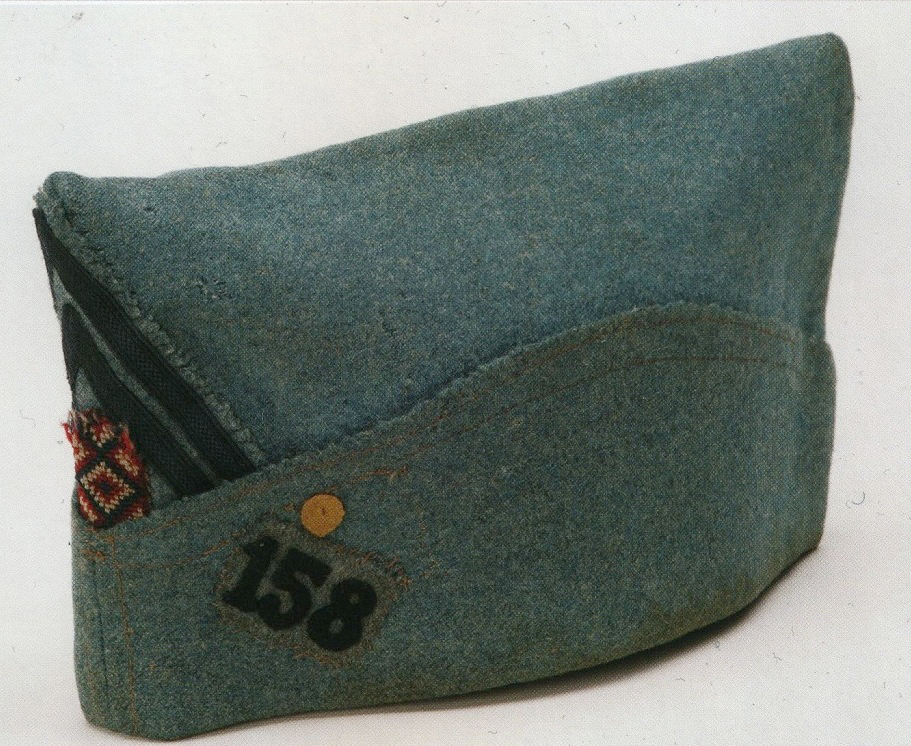
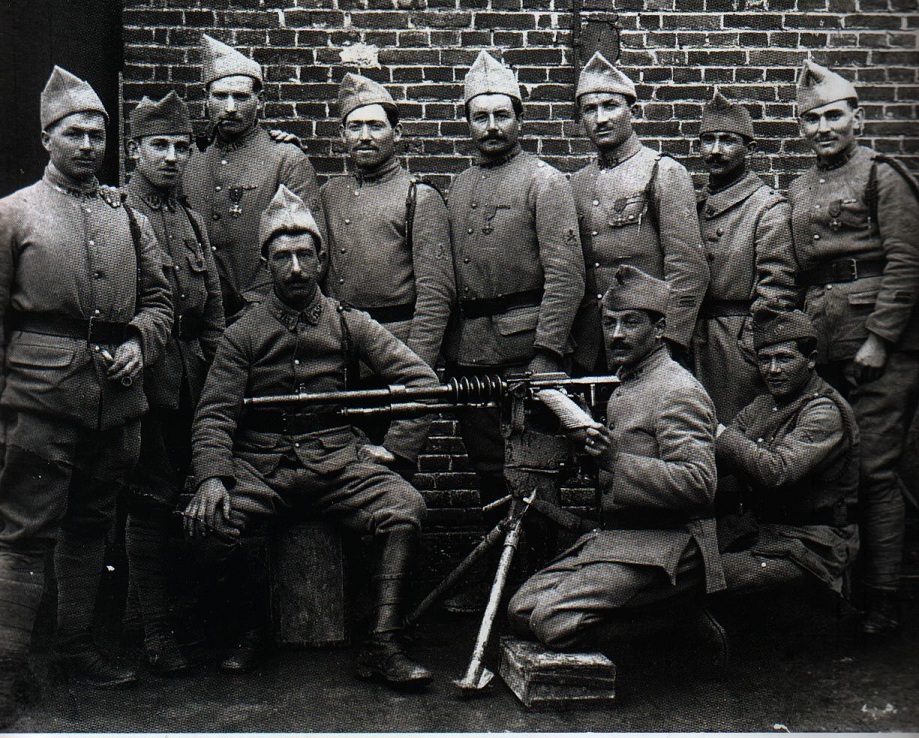
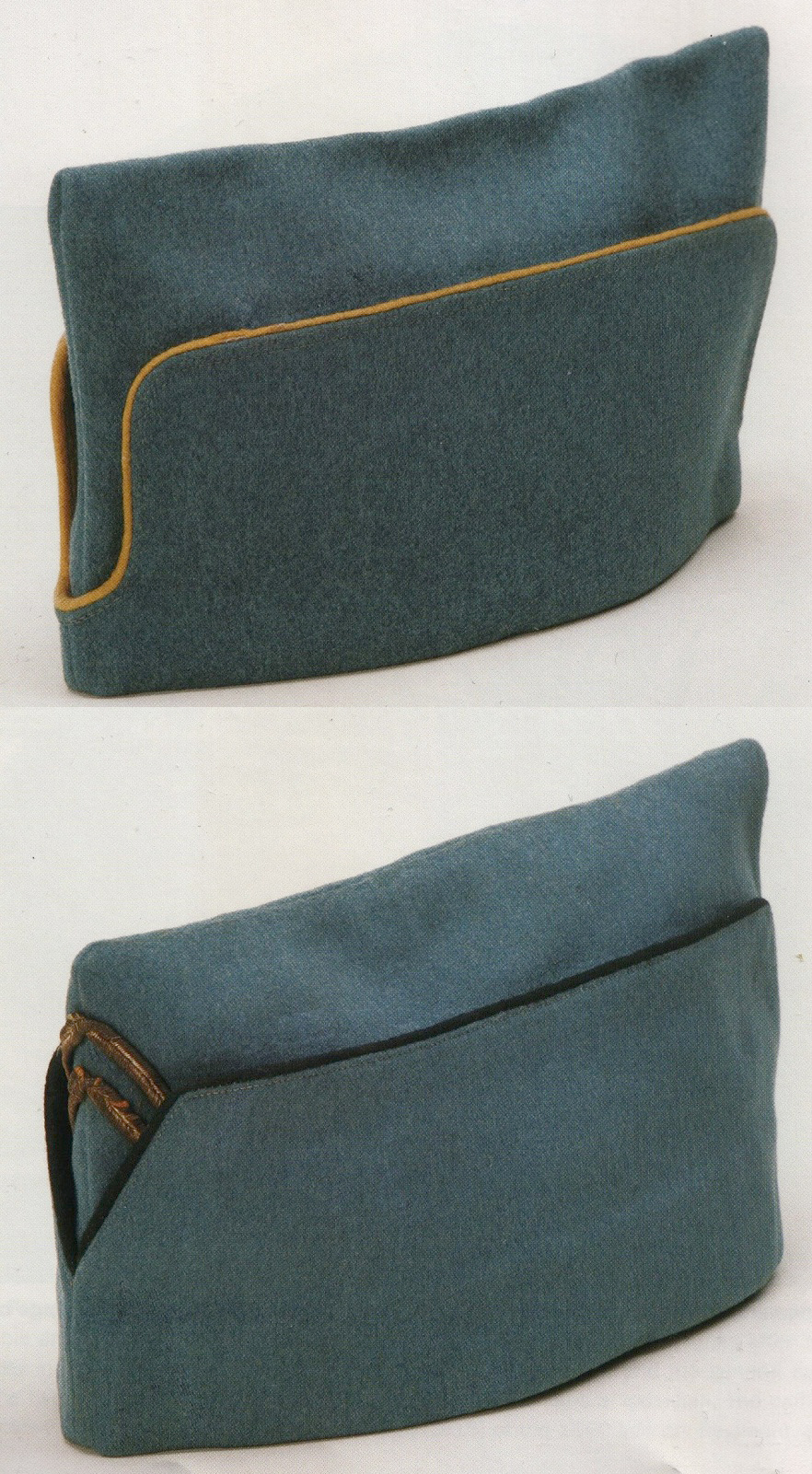
Private Purchase: Some men opted to purchase privately made bonnets that offered a more stylish look while still conforming to the regulation models in basic cut. The most common form of embellishment can in the form of piping (yellow for infantry, black for engineers, blue for cavalry, red for artillery, green for sanitary). This was added to the top edges of the side flaps for a meager 75 cents. Piping was never regulation but it was popular. There was a great variety of private purchase bonnets in the design of the M1918. Generally these were made in a finer quality of of "NCO's" cloth. Nicer versions had a headband made of leather. The cost was typically sold for 3.25 francs (M1891 private made bonnets sold typically for 2.95 francs).
Two private purchase 'Empire' style bonnets of fine wool. The top one has yellow (infantry) piping; the bottom one has black (engineers) piping as well as gold rank piping (lieutenant).





